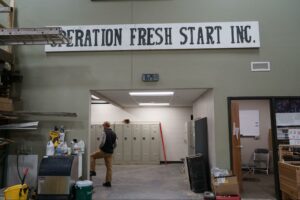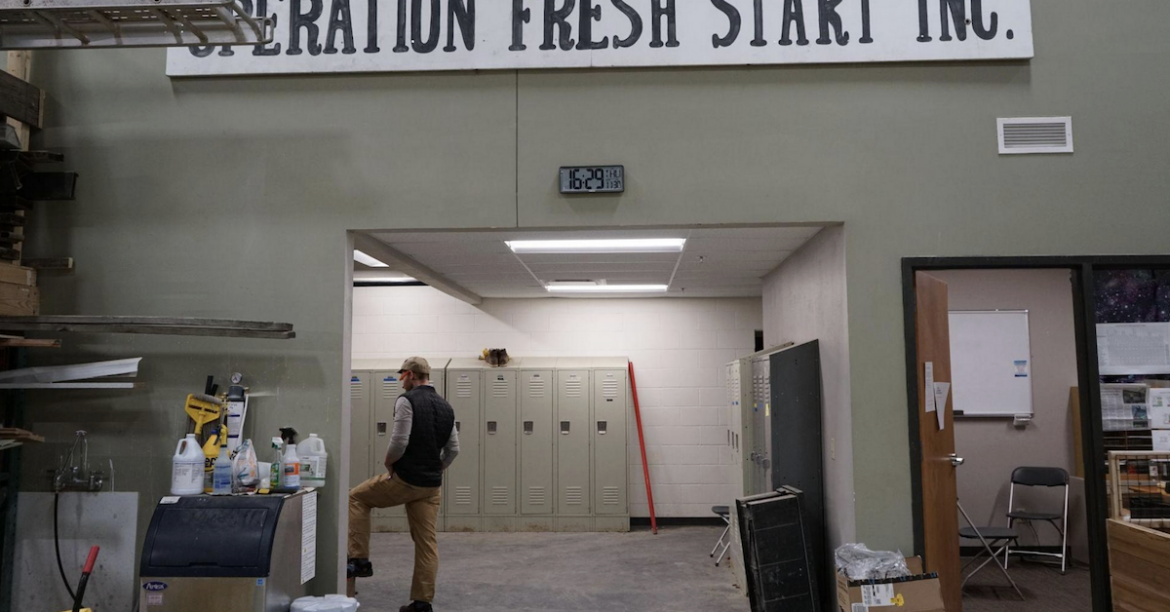Ryan Raschke learned the carpentry trade from his father. He recently returned to Wisconsin to become a supervisor for Build Academy, a program run by the Madison-based nonprofit Operation Fresh Start.
Build Academy trains emerging adults, ages 18-24, to enter the building trades.
Raschke reflected on why he wanted to teach construction fundamentals to young people.
“As opposed to the fact that I could have had any carpentry job I wanted?” he asked with a chuckle. “After almost a two-generation vacuum of Americans who just have not gone into blue collar work, I see this country facing a critical infrastructure issue. The only way to solve it is to prepare young people to enter the trades.”
Indeed, Wisconsin’s builders are aging, with one in five laborers being 55 or older, according to the Associated Builders and Contractors of Wisconsin.
Nationally, the application rate for young people seeking technical jobs, such as building or electrical work, dropped by half between 2020 and 2022, according to a January 2023 NPR report. A significant barrier for people who are beginning their careers is the three- to five-year time commitment to intense apprentice training that building jobs require. Madison’s Build Academy helps its participants navigate the building industry, guiding them through bureaucracy to stable careers.
The pathway to an apprenticeship is long and winding, said Laura Dresser, associate director of the Center on Wisconsin Strategy, or COWS. The industry’s many union trades make acquiring an apprenticeship “challenging even to understand,” she said.
Tradespeople who work without union representation, Dresser said, lose out on the unions’ strong negotiated wages and benefits. It also leaves them vulnerable to employers fraudulently misclassifying them as independent contractors rather than employees (see sidebar).
However, unions dominate Wisconsin’s commercial construction industry, organizing labor into distinct trades that perform specialized, often industrial-focused work. And apprenticeships are the necessary step to getting union work.
The Wisconsin Building Trades Council has 15 member organizations, with each specializing in a different trade, including electrical work, elevator construction, heating and cooling installation, roofing and more.
Some member organizations are so broad that they represent multiple unions, which can each represent multiple trades. Each trade has its own apprenticeship.
Dresser said apprenticeship applicants must first know what their skills are, which of the many trades appeal to them and who they want to work for. Then, in becoming an apprentice, they make a three- to- five-year commitment to that specialization.
“This is why I think sometimes it helps to have family members who understand the trade,” Dresser said. “There’s a lot of inside knowledge that’s hard to understand.”
That’s where Build Academy comes in.
Faith Neumann is the program coordinator for Build Academy. A chorus of whirring saws and buzzing drills accompanied her explanation of the program.

Build Academy has three steps, each of which provide program participants with paid hourly wages, Neumann said.
Upon acceptance into the program, a new participant begins a three-week course called “mental toughness.” The course teaches students tool safety, construction math, blueprint literacy, using chalk lines for layouts and other necessary lessons for working on a construction site.
“A lot of people don’t realize that a two-by-four is not actually two inches by four inches,” Neumann said. “It’s one-and-a-half by three-and-a-half.”
After mental toughness, participants graduate to Tier 1. Here, they work in crews on residential development projects around Dane County. Their work involves remodeling, demolition or “from-the-ground-up” construction. The participants, some of whom are as young as 18, perform tasks that are not considered specialized work, like plumbing, heating and HVAC.
“We’re framing it, insulating it, drywalling it. Usually we’ll mud and tape it,” Neumann said. “Installing the windows, setting the doors, doing the trim, installing the floors, doing the painting.”

Tier 1 participants will also undergo a “pre-apprenticeship” process, where they get first aid, safety and CPR training, and a driver's license attainment plan.
In Tier 2, participants join professional commercial construction sites, where they work on developments with seasoned industry professionals. They also get a one dollar raise to their hourly wages.
Lukas Thatcher, 18, and Ramiro Montes-Lopez, 19, are Tier 2 participants. They are currently building the UW Eastpark Medical Center on Madison’s east side.
“We’re in this program, we’re making it, and now we’re looking at becoming Steamfitters,” said Thatcher. “Kinda sets you up for life.”
Steamfitters lay and maintain high-pressure piping, commonly used for oil and gas transportation, electricity generation and other industrial applications.
The two boys returned from a Steamfitters orientation, set on entering that trade.
“How’d it go?” Neumann asked, as the boys congregated in her office. “Did you present yourself good? Shaking hands?”
“I pretty much knew all of the stuff already,” Thatcher replied. “We both did.”

The orientation meeting is the first step in applying for a Steamfitters apprenticeship. Next, Thatcher and Montes-Lopez must submit their high school transcripts, take an SAT/ACT-adjacent test called the “accuplacer” and pass specialty exams for the Steamfitters union.
Neumann said the high pay, long-term stability and great benefits are the trades’ attractive selling points for young people.
“Amazing benefits, high pay, you learn a skill, you’re able to take care of your future family. If you wanted to, you could have your own business doing it,” she said. “You could repair your own home, save money, and then there’s the pride aspect.”
When asked why he followed his father into the trades, Ryan Raschke lifted his hands and rubbed his fingers together — it’s good money, he said.
Across the board, building trades unions offer notoriously high minimum hourly wages, Neumann said. An apprentice’s hourly wage starts at half the standard, or “journeyman,” wage. Overtime, apprentices’ wages increase until they become “journeymen,” eligible for the standard wage.
In south central Wisconsin, roofing pays the lowest minimum wage, at $28 per hour, to union journeymen. General laborers’ minimum hourly wage is $31.20. Painters’ is $32.98. As trades specialize, their minimum base wages increase. Plumbers, for example, have a base minimum wage of $48.67. Steamfitters’ is $50.55, and elevator constructors’ is $57.42.
“You just gotta be patient,” Thatcher said.






